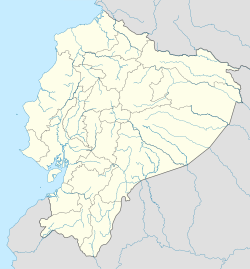
Guayaquil, officially Santiago de Guayaquil, is the largest city in Ecuador and also the nation's economic capital and main port. The city is the capital of Guayas Province and the seat of Guayaquil Canton. The city is located on the west bank of the Guayas River, which flows into the Pacific Ocean at the Gulf of Guayaquil.

Manta, also known as San Pablo de Manta, is a city in Ecuador, cantonal head of the Manta Canton, as well as the largest and most populated city in the Manabí Province. It is the seventh most populous in the country. Manta has existed since Pre-Columbian times. It was a trading post for the Manta, also known as Manteños.

La Punta is a district of the Constitutional Province of Callao in Peru, and one of the seven districts that make up the port city of Callao. It is located in a peninsula in the western part of the province and is almost entirely surrounded by the Pacific Ocean, except on its northeastern side, where it is bordered by downtown Callao.

Santa Elena is a town in southwestern Ecuador, and is the capital of both the province and the canton of the same name. Santa Elena, originally called Sumpa, is located on the Ecuadorian peninsula near the city of Guayaquil. It is regarded as the location of the most important and best documented archaeological site in the country, predominantly due to the discovery of the Lovers of Sumpa.

Montañita is a small coastal town in Ecuador located in the parish of Manglaralto, province of Santa Elena, about 180 kilometers northwest of Guayaquil. Its name means "small mountain." In the mid 20th century it was known as a surfing beach, with only a few fishermen's huts, and one or two surfers tents in summer, erected at the site. But in 1960, Montañita, foreigners linked to the hippie movement decided to settle there permanently. It is now a popular destination for surfers from around the world and considered one of the best surfing beaches in Ecuador's south coast.
Xavier Blum Pinto is an Ecuadorian artist. From 1974 to 1976 he studied architecture at the Universidad Catolica Santiago de Guayaquil, in Ecuador. In 1981, obtained his MA in Fine Arts from the Universitė of Paris VIII, France.

"Las Vegas culture" is the name given to many Archaic settlements which flourished between 8000 BCE and 4600 BCE near the coast of present-day Ecuador. The name comes from the location of the most prominent settlement, Site No. 80, near the Las Vegas River and now within the city of Santa Elena. The Las Vegas culture represents "an early, sedentary adjustment to an ecologically complex coastal environment."

The Machalilla were a prehistoric people in Ecuador, in southern Manabí and the Santa Elena Peninsula. The dates when the culture thrived are uncertain, but are generally agreed to encompass 1500 BCE to 1100 BCE.

Pre-Columbian Ecuador included numerous indigenous cultures, who thrived for thousands of years before the ascent of the Incan Empire. Las Vegas culture of coastal Ecuador, flourishing between 8000 and 4600 BC, is one of the oldest cultures in the Americas. The subsequent Valdivia culture in the Pacific coast region is another well-known early Ecuadorian culture. Ancient Valdivian artifacts from as early as 3500 BC have been found along the coast north of the Guayas Province in the modern city of Santa Elena.

The Chorrera culture or Chorrera tradition is a Late Formative indigenous culture that flourished between 1300 BCE and 300 BCE in Ecuador. Chorrera culture was one of the most widespread cultures in pre-Columbian Ecuador, spanning the Pacific lowlands to the Andean highlands, and even into southern Colombia.

The XVI Bolivarian Games were a multi-sport event held in 2009 in Sucre, Bolivia. The competitions in Sucre took place from 15–26 November. A number of Bolivian cities hosted some of the sporting events, including Cochabamba, Santa Cruz and Tarija. Also, events were held outside of Bolivia, with Guayaquil, Lima, Quito and Salinas hosting a number of competitions. The Games were organized by the Bolivarian Sports Organization (ODEBO).

The Guabo is a canton in the province of El Oro in Ecuador. Its capital is the city cantonal Guabo. Its population in the 2010 census was 50,009 inhabitants. The date of canton of El Guabo was September 7, 1978. The mayor for the period 2009-2014 was John Franco Aguilar.

General Villamil, also known as Playas, is a Guayas canton in Ecuador. The Playas canton is located at the south western area of the Guayas Province. Its Canton Capital is General José de Villamil, also known as Playas. It is located 96 kilómeters from the capital of the Guayas Province, Guayaquil. It borders to the north and east with Guayaquil Canton, on the west with Santa Elena Province, and to south with the Pacific Ocean. Its territory has an area of 280 square kilometres and has a population of 31,000 citizens, with 25,000 of them living in the canton's capital.

Punta Carneros is an island located in the Salinas County, in the Santa Elena Province of Ecuador.

Ecuador has many beaches for surfing: the coast of Ecuador is 2,237 km long. Surfable waves are available in Ecuador year-round, and surfers enjoy the mild year-round weather, especially in the northern region where the weather conditions attract many surfers from all over the world. Within this part of South America, Ecuador's neighbors Chile and Peru also offer great surfing. Many surfers in Ecuador use a protective wetsuit. Surf tourism is very important to the local economy, and the beaches offer significant enjoyment because of top quality waves combined with affordable prices for lodging and food compared to other surf destinations. There's also a national marine reserve off the coast, which has a gigantic whale population.

The Amazing Race 6 is the sixth season of the Latin American version of the American reality show The Amazing Race. As in seasons prior, the show consisted of 11 teams of different nationalities competing, though this season took place entirely in Ecuador. The program was broadcast throughout Latin America on cable network Space, and in Ecuador on TC Televisión. The prize for the winning team was US$100,000, which was less than the prize given in previous seasons.
Ecuador is a country with vast natural and cultural wealth. The diversity of its four regions has resulted in hundreds of thousands of species of flora and fauna. It has about 1640 species of birds. The species of butterflies line the 4,500, the 345 reptiles, 358 amphibians and 258 mammals, among others. Ecuador is considered one of the 17 countries where the greatest biodiversity of the planet is concentrated. Most of its flora and fauna live in 26 areas protected by the State. It also offers historical attractions such as Quito, food and a variety of cultures and traditions.

The State University Santa Elena Peninsula is a public university located in the canton freedom of the province of Santa Elena in the Republic of Ecuador, is the first autonomous center of teaching and which has the largest student population in the area.

The Roman Catholic Diocese of Santa Elena is a diocese located in the town of Santa Elena in the Ecclesiastical province of Guayaquil in Ecuador.























